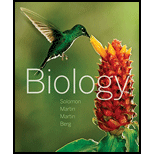
Concept explainers
A nucleosome consists of (a) DNA and scaffolding proteins (b) scaffolding proteins and histones (c) DNA and histones (d) DNA, histones, and scaffolding proteins (e) histones only
Introduction: A chromosome is a thread-like structure made up of DNA. It is tightly packed in the nucleus of a cell. Humans normally have 23 pairs of chromosomes.
Answer to Problem 1TYU
Correct answer: A nucleosome consists of DNA and histones. Hence, the correct answer is option (c).
Explanation of Solution
Reason for the correct answer:
The nucleosome is the basic unit of chromatin structures. The basic unit of each nucleosome contains a bead-like structure that has 146 DNA base pairs wrapped around the disc-shaped core of eight histone molecules. The nucleosomes prevent the DNA from becoming tangled. Histones play an important part in the regulation of gene expression.
Option (c) is given as “DNA and histones”.
The nucleosome consists of DNA and histones.
Hence, the correct answer is option (c).
Reasons for the incorrect answers:
Option (a) is given as “DNA and scaffolding proteins”.
Nucleosomes consist of DNA, but scaffolding proteins are not present in nucleosomes.
Hence, option (a) is incorrect.
Option (b) is given as “scaffolding proteins and histones”.
Scaffolding proteins are modular proteins that play a crucial role in cell-signaling pathways. Scaffolding proteins are not present in nucleosomes. Histones proteins are present in nucleosomes.
Hence, option (b) is incorrect.
Option (d) is given as, “DNA, histones, and scaffolding proteins”.
Nucleosomes consist of DNA and histones, but scaffolding proteins are not present. Hence, option (d) is incorrect.
Option (e) is given as, “histones only”.
Not only histones, but DNA is also present in the nucleosomes.
Hence, option (e) is incorrect.
Hence, options (a), (b), (d), and (e) are incorrect.
The nucleosome is the basic unit of chromatin structures that consist of DNA and histones.
Want to see more full solutions like this?
Chapter 10 Solutions
Biology (MindTap Course List)
- Find out about the organisations and the movements aimed at the conservation of our natural resources. Eg Chipko movement and Greenpeace. Make a project report on such an organisation.arrow_forwardWhat are biofertilizers and mention the significancearrow_forwardPCBs and River Otters: Otters in Washington State’s Green-Duwamish River have high levels of polychlorinated biphenyls (PCBs) in their livers. PCBs can bind to the estrogen receptors in animals and disrupt the endocrine system of these otters. The PCBs seem to increase the estrogen to androgen ratio, skewing the ratio toward too much estrogen. How would increased estrogen affect the river otter population? Based on your reading of the materials in this unit, what factors can affect fertility in humans? Explain how each of the factors affecting human fertility that you described can disrupt the human endocrine system to affect reproduction.arrow_forward
- Other than oil and alcohol, are there other liquids you could compare to water (that are liquid at room temperature)? How is water unique compared to these other liquids? What follow-up experiment would you like to do, and how would you relate it to your life?arrow_forwardSelection of Traits What adaptations do scavengers have for locating and feeding on prey? What adaptations do predators have for capturing and consuming prey?arrow_forwardCompetition Between Species What natural processes limit populations from growing too large? What are some resources organisms can compete over in their natural habitat?arrow_forward
- Species Interactions Explain how predators, prey and scavengers interact. Explain whether predators and scavengers are necessary or beneficial for an ecosystem.arrow_forwardmagine that you are conducting research on fruit type and seed dispersal. You submitted a paper to a peer-reviewed journal that addresses the factors that impact fruit type and seed dispersal mechanisms in plants of Central America. The editor of the journal communicates that your paper may be published if you make ‘minor revisions’ to the document. Describe two characteristics that you would expect in seeds that are dispersed by the wind. Contrast this with what you would expect for seeds that are gathered, buried or eaten by animals, and explain why they are different. (Editor’s note: Providing this information in your discussion will help readers to consider the significance of the research).arrow_forwardWhat is the difference between Uniporters, Symporters and Antiporters? Which of these are examples of active transport?arrow_forward

 Biology (MindTap Course List)BiologyISBN:9781337392938Author:Eldra Solomon, Charles Martin, Diana W. Martin, Linda R. BergPublisher:Cengage Learning
Biology (MindTap Course List)BiologyISBN:9781337392938Author:Eldra Solomon, Charles Martin, Diana W. Martin, Linda R. BergPublisher:Cengage Learning Human Heredity: Principles and Issues (MindTap Co...BiologyISBN:9781305251052Author:Michael CummingsPublisher:Cengage Learning
Human Heredity: Principles and Issues (MindTap Co...BiologyISBN:9781305251052Author:Michael CummingsPublisher:Cengage Learning Anatomy & PhysiologyBiologyISBN:9781938168130Author:Kelly A. Young, James A. Wise, Peter DeSaix, Dean H. Kruse, Brandon Poe, Eddie Johnson, Jody E. Johnson, Oksana Korol, J. Gordon Betts, Mark WomblePublisher:OpenStax College
Anatomy & PhysiologyBiologyISBN:9781938168130Author:Kelly A. Young, James A. Wise, Peter DeSaix, Dean H. Kruse, Brandon Poe, Eddie Johnson, Jody E. Johnson, Oksana Korol, J. Gordon Betts, Mark WomblePublisher:OpenStax College Biology: The Dynamic Science (MindTap Course List)BiologyISBN:9781305389892Author:Peter J. Russell, Paul E. Hertz, Beverly McMillanPublisher:Cengage Learning
Biology: The Dynamic Science (MindTap Course List)BiologyISBN:9781305389892Author:Peter J. Russell, Paul E. Hertz, Beverly McMillanPublisher:Cengage Learning Concepts of BiologyBiologyISBN:9781938168116Author:Samantha Fowler, Rebecca Roush, James WisePublisher:OpenStax College
Concepts of BiologyBiologyISBN:9781938168116Author:Samantha Fowler, Rebecca Roush, James WisePublisher:OpenStax College





